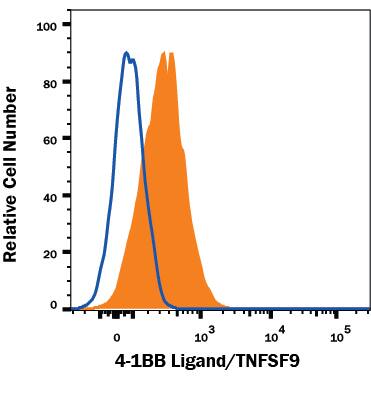Human 4-1BB Ligand/TNFSF9 Antibody
R&D Systems, part of Bio-Techne | Catalog # MAB22952
Recombinant Monoclonal Antibody.


Conjugate
Catalog #
Key Product Details
Species Reactivity
Human
Applications
CyTOF-ready, Flow Cytometry
Label
Unconjugated
Antibody Source
Recombinant Monoclonal Rabbit IgG Clone # 2357A
Product Specifications
Immunogen
E. coli-derived human 4-1BB Ligand/TNFSF9
Arg71-Glu254
Accession # P41273.1
Arg71-Glu254
Accession # P41273.1
Specificity
Detects human 4-1BB Ligand/TNFSF9 in direct ELISA.
Clonality
Monoclonal
Host
Rabbit
Isotype
IgG
Scientific Data Images for Human 4-1BB Ligand/TNFSF9 Antibody
Detection of 4‑1BB Ligand/TNFSF9 in Human Daudi cell line by Flow Cytometry.
Human Daudi Burkitt lymphoma cell line was stained with Rabbit Anti-Human 4-1BB Ligand/TNFSF9 Mono-clonal Antibody (Catalog # MAB22952, filled histogram) or isotype control antibody (Catalog # MAB1050, open histogram), followed by PE-conjugated Anti-Rabbit IgG Secondary Antibody (Catalog # F0110). View our protocol for Staining Membrane-associated Proteins.Applications for Human 4-1BB Ligand/TNFSF9 Antibody
Application
Recommended Usage
CyTOF-ready
Ready to be labeled using established conjugation methods. No BSA or other carrier proteins that could interfere with conjugation.
Flow Cytometry
0.25 µg/106 cells
Sample: Human Daudi cell line
Sample: Human Daudi cell line
Formulation, Preparation, and Storage
Purification
Protein A or G purified from cell culture supernatant
Reconstitution
Reconstitute at 0.5 mg/mL in sterile PBS. For liquid material, refer to CoA for concentration.
Formulation
Lyophilized from a 0.2 μm filtered solution in PBS with Trehalose. *Small pack size (SP) is supplied either lyophilized or as a 0.2 µm filtered solution in PBS.
Shipping
Lyophilized product is shipped at ambient temperature. Liquid small pack size (-SP) is shipped with polar packs. Upon receipt, store immediately at the temperature recommended below.
Stability & Storage
Use a manual defrost freezer and avoid repeated freeze-thaw cycles.
- 12 months from date of receipt, -20 to -70 °C as supplied.
- 1 month, 2 to 8 °C under sterile conditions after reconstitution.
- 6 months, -20 to -70 °C under sterile conditions after reconstitution.
Background: 4-1BB Ligand/TNFSF9
4-1BB Ligand binds to 4-1BB/TNFRSF9/CD137 on activated CD4+ and CD8+ T cells, thymocytes, and NK cells as well as on monocytes, neutrophils, DC, and eosinophils. In response to 4-1BB Ligand binding, 4-1BB transduces a co-stimulatory signal that promotes the proliferation, activation, and survival of CD4+ and CD8+ T cells (4, 11, 12). T cell co-stimulation through CD28 is important for the initial T cell expansion, while 4-1BB acts later in the response (12, 13). 4-1BB Ligand function supports the survival and responsiveness of memory T cells during viral infection (13-15). Reverse signaling through 4-1BB Ligand on monocytes induces the production of inflammatory cytokines (5). On macrophages, 4-1BB Ligand associates in cis with TLR4 and enhances inflammatory cytokine production in response to TLR4 ligation (6). Its expression on early myeloid progenitor cells limits the development of dendritic cells, monocytes, and B cells (9).
References
- Wang, C. et al. (2009) Immunol. Rev. 229:192.
- Alderson, M.R. et al. (1994) Eur. J. Immunol. 24:2219.
- Reali, C. et al. (2003) J. Neurosci. Res. 74:67.
- DeBenedette, M.A. et al. (1997) J. Immunol. 158:551.
- Langstein, J. et al. (1998) J. Immunol. 160:2488.
- Kang, Y.J. et al. (2007) Nat. Immunol. 8:601.
- Baessler, T. et al. (2010) Blood 115:3058.
- Gullo, C. et al. (2010) PLoS One 5:e10845.
- Lee, S.-W. et al. (2008) Nat. Immunol. 9:917.
- Salih, H.R. et al. (2001) J. Immunol. 167:4059.
- Wen, T. et al. (2002) J. Immunol. 168:4897.
- Cannons, J.L. et al. (2001) J. Immunol. 167:1313.
- Bertram, E.M. et al. (2002) J. Immunol. 168:3777.
- Bukczynski, J. et al. (2004) Proc. Natl. Acad. Sci. USA 101:1291.
- Lin, G.H.Y. et al. (2009) J. Immunol. 182:934.
Alternate Names
41BB Ligand, CD137L, TNFSF9
Gene Symbol
TNFSF9
UniProt
Additional 4-1BB Ligand/TNFSF9 Products
Product Documents for Human 4-1BB Ligand/TNFSF9 Antibody
Product Specific Notices for Human 4-1BB Ligand/TNFSF9 Antibody
For research use only
